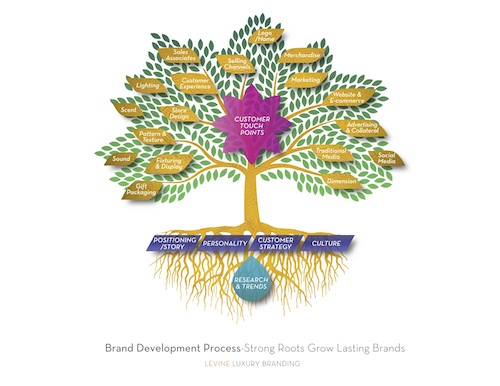Articles and News
Is Your Brand Working The Way It Should? Q&A With Luxury Branding Expert Pam Levine | July 08, 2015 (0 comments)

New York, NY—Pam Levine is the president of Levine Luxury Branding, a strategic branding and consumer engagement design firm serving the luxury market. She is a frequently sought speaker in retail circles, having recently made presentations to the Luxury Marketing Council, the International Retail Design Summit in Germany, Globalshop, and many more events. Some of her clients include such venerable luxury names as Cartier, Christian Dior, Michael Aram, Tourneau, and World Gold Council. The Centurion spoke with Levine in an exclusive interview about how independent jewelers can ensure their brand remains relevant as the luxury market evolves.
The Centurion: What is the most important element of luxury branding?
Pam Levine: The most important is to go through a cohesive, formal branding process. A brand is built from the inside out—or as I like to say, from the insight out. I created this special tree to illustrate how a brand is built. Many luxury jewelers have a name, a logo, and a nice store that’s been in the family, or they find a nice area and open their doors, without really exploring and understanding what makes them unique. They look at their [retail] neighbor or another successful jeweler and say, ‘I’d like to look like that,’ but then they wonder why they’re not distinctive. But being distinctive does take a certain personality: a risk-taker. An outside expert can help you craft a dynamic, 360-degree experience for your customers. And because many retailers do associate and socialize with their customers, it’s one of the best ways to establish brand communication.

Centurion: What elements of branding are less important than jewelers might think?
Levine: Any element or touch-point of your communication to customers is important. There’s no area where a luxury jeweler can slack off in creating a dynamic 360-degree experience for customers. Your windows, your mailers, your website, your product, your merchandising, your salespeople all have to align to communicate your brand promise to customers. The purchase of a piece of jewelry is the experience, and something a jeweler can exploit in the store.
Centurion: Is there any element of luxury branding that jewelers tend to forget or not know?
Levine: I think jewelers underestimate the value of communicating price information to customers. You can do it tastefully, and through merchandising and store layout. For example, give a range for the showcase on a small crystal sign, or put your most expensive pieces in the back or in a private salon. You don’t have to price out each piece, but you do have to communicate what the prices are so that people understand and can shop on their own.
All of us look for some kind of experience, especially when we walk into a luxury store, and nobody wants to ask the price and find out it’s not in the budget. People aren’t comfortable asking about prices—especially Millennials—and especially in a luxury store. That’s not a good experience.
That’s also one of the reasons why digital is so important. No other product is as difficult to access as jewelry because it’s locked in a showcase. But shopping online makes it feel a little more accessible. You can blow it up, really look at it, and feel closer to the product than in the store. Even if you don’t own it, when it’s on your mobile device, there’s a subliminal sense of accessibility and belonging.
Centurion: There’s so much talk about how luxury is changing. What do you think is changing?
Levine: Everything from customer values, shopping habits, and mindset has changed. The downturn affected everyone. Even if it didn’t affect your wallet, it affected your mind. Plus there’s been a democratization of jewelry and it’s more accessible. Big-box stores sell jewelry and anyone can access information about jewelry. That’s why special shopping experiences will never go away.
Centurion: Can luxury jewelry have an affordable price tag? Or is it truly meant only for the rich?
Levine: I think you can’t really separate the luxury experience from the product. If you go into Tiffany and buy the Elsa Peretti bean for a few hundred dollars, that’s a luxury experience. So yes, I think silver and smaller items that aren’t expensive can be considered luxury—if the experience of buying them is luxury.
Centurion: Where do you define “mid-market” for luxury jewelers?
Levine: Wow, that’s a loaded question! Jewelers have to think of this within their world, and it depends what it is. In broad terms, I think of it starting around $1,000, but anywhere from $300 to $1,500. Jewelry has what I call ‘past drag’ on it. People still value jewelry or look at it as a different entity than other things they spend money on, so even if it’s the same price, they think about it differently. $3,000 [jewelry] isn’t an impulse item—at least, it’s not as impulsive as a bag or shoes that cost the same.
There’s a fine balance. Jewelers can become prisoners of their merchandise. They buy expensive things they fall in love with, but then it doesn’t move and their stores look old. So then they’re afraid to buy [high-end products] and they don’t invest in it enough. But if you don’t have it, how do you get the high-end customer? It doesn’t have to be a lot, and it can be in a salon or black box, and not so visible, but it has to be enough to whet their appetite and let them know you have it.
Centurion: Income disparity is a big topic of discussion. Even the president of Richemont recently said it keeps him up at night, and brands like Gucci and Louis Vuitton are seeing a drop in sales of logo goods. How will this impact independent luxury jewelers?
Levine: People haven’t stopped spending money; they’re just spending it differently. Van Cleef & Arpels is doing very well and Hermès’s website is youthful, Millennial-oriented, and so much fun you don’t want to leave. And luxury watch sales are very strong. We may not have as many stores, but we’re oversaturated anyway. But brands are so ingrained in our lives and kids and babies are brought up on brands. Independent jewelers can personalize, curate, and build their own brand.
Centurion: There’s also a lot of discussion that Millennials don’t value things as much as experiences, and that many are still decades away from affluence. How can independent jewelers position themselves to remain relevant both now with Boomers and in the future with Millennials?
Levine: There are already a lot of affluent Millennials, but I think it’s where Millennials place value—where each of us places value. Again, it comes back to experience. If a Millennial has a relationship with a jeweler through their parents, that helps, but a store experience can win their loyalty.
Stores have to start integrating a digital experience so that the customer can access the information on their own and discover it on their own. There’s a company called Perch, which makes a digital table to put products on, and content from the website comes up when the product is put there, so the customer can discover more. It’s easily translatable to jewelry. You discover the information on your own, it’s fun, and it’s not being pushed at you.
There’s always the security issue [in jewelry] when you see innovative concepts, so maybe you don’t put your highest-end pieces on it.
Centurion: How do you replicate your in-store shopping experience online?
Levine: I go back to ‘what is your story?’ ‘what makes you unique?’ ‘what’s creating a buzz?’ Once you have that, once you see how people are responding on social media, build on that in store and online. Think of your site as an extension of your store, with no wall between the two. It’s a constant conversation. Stores undergoing a redesign have even asked customers’ input on colors, the new store, new packaging, et cetera. Don’t stop with one conversation; make sure your conversation is relevant, current, and updated. Keep going, building, and engaging. That’s when loyalty really happens.







